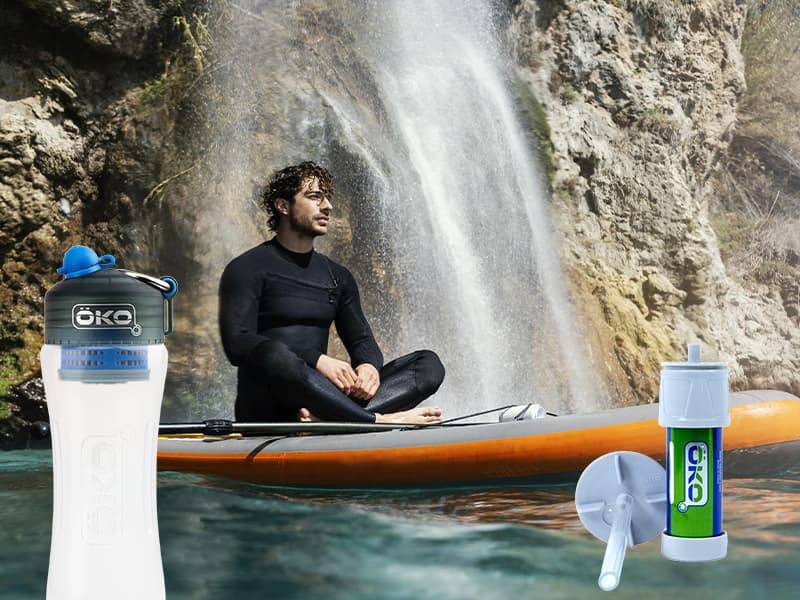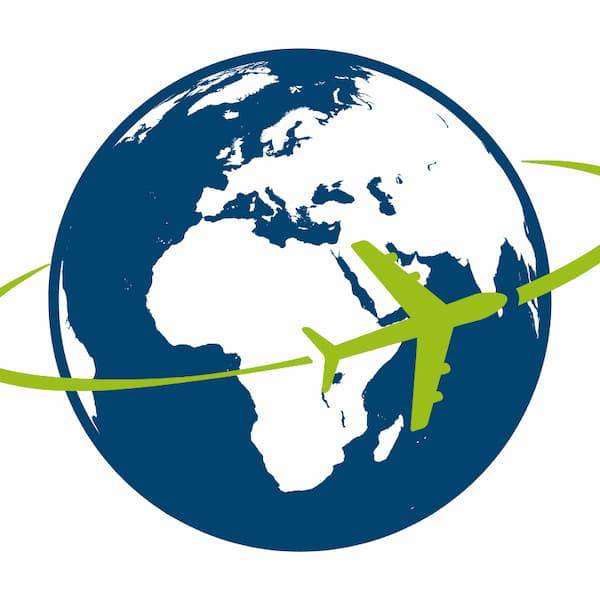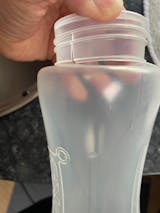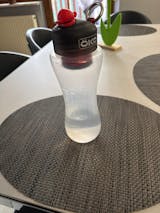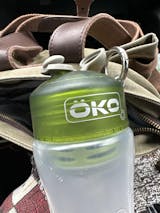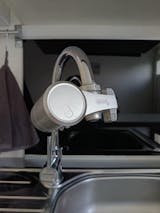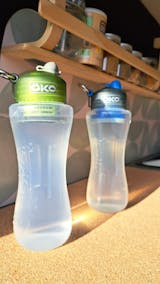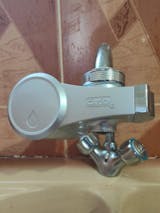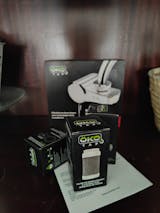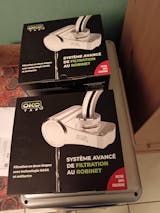Très pratique pour toute activité professionnelle ou loisir 👍
Seul petit bémol un peu fragile une chute et la gourde est cassée 😢
J’ai acheté la gourde filtrante Eco en version 1 litre et j’en suis vraiment satisfaite. Elle est simple à utiliser, légère et tient bien en main. Le système de filtration est efficace : l’eau a meilleur goût et je la bois en toute confiance, que ce soit à la maison, au travail ou en déplacement.
La contenance d’un litre est parfaite pour la journée, et le bouchon se ferme bien, donc pas de fuite dans le sac. Le nettoyage est facile et le filtre se change rapidement.
C’est un achat que je ne regrette pas : pratique, économique et écologique
Un peu déboussolé par le fait de boire sans aspirer, j’ai eu du mal à m’habituer mais du coup l’eau est très très bonne et j’ai une grande confiance dans ce système de filtration donc et ben quand je l’ai plus ou que je l’oublie, elle me manque petit plus avec l’application qui vous rappelle de laver les embout et qui vous donne la date de changement du filtre. J’ai 650 ml qui convient très bien à mon sac, donc je peux l’emmener partout.
Vu sur les réseaux sociaux au début, le site m'a confirmé mon achat du filtre pour robinet, suite à des problèmes mineurs sur l'eau distribuée dans ma ville.
L'ensemble prend un peu de place mais reste pratique à la manipulation.
Après 2 ans de voyage en van de la France au Népal, on a sans hésiter investi dans 2 gourdes ÖKO car même si nous avions un système de filtration d'eau dans notre van, on s'est souvent retrouvés en bivouac ou en randos de plusieurs jours où la gourde ÕKO nous a bien manqué.
Être autonomes à l'autre bout du monde même en sacs à dos sans devoir acheter de l'eau en bouteilles : le top pour nous, comme pour la planète ! Avec nos 2 gourdes et notre réserve de filtres, nous sommes prêts à repartir en tour du monde !
J' ai acheté le filtre adaptable sur le robinet entant que ancien militaire je recommande vivement, la différence d'eau se remarque d'une façon incroyable ,nous sommes partis à l'étranger pour plusieurs mois et nous l'avons apporté avec ,le démontage et le remontage ce fait d'une façon très simple . Pour le poid des bagages pas de souci, il est super léger,on ce prend plus la tête à transporter de l'eau en bouteille c'est vraiment une révolution
J'ai acheté 3 filtres pour mon système de filtration mon permettant d'aller sur un an de consommation et le fait de les avoirs acheter en lots,ça ma permis d'avoir une réduction,a chaque fois que j'ai un besoin il y a une réduction,c'est super,merci OKO ,je kiff.
La gourde filtrante OKO est pour nous une compagne de voyage inséparable: à la mer, à la montagne, en avion, à moto ou au travail, elle est toujours avec nous.
Nous n’avons plus besoin d’acheter des bouteilles en plastique, ni de chercher où les recycler.
Son filtre de 378 litres est pratiquement inépuisable et nous n’avons plus à nous soucier de la qualité de l’eau du robinet: il élimine les bactéries et les contaminants.
Nous l’utilisons même à la maison, à la place des lourds packs de bouteilles d’un litre et demi.
Bref, nous ne pouvons plus nous passer de la gourde filtrante OKO !
Merci pour cette invention fantastique !
D'abord, période covid, mes enfants et moi avions commandé les gourdes, satisfaction complète. Puis la filtration sur robinet est arrivée, et voilà, 3 commandes, excellent cadeau de Noël !
Pas de désillusion, le dispositif répond à nos attentes au niveau du goût. Nous avons également constaté une absence de calcaire au fond de nos casseroles suite à l'ébullition de l'eau. Et quelle praticité, ça change des carafes lourdes à remplir et garder au réfrigérateur. En ce qui concerne l'efficacité face aux nombreux polluants, nous faisons confiance aux études effectuées par des laboratoires indépendants. Pour le moment TAP c'est TOP 🙂
J’utilise ma gourde au quotidien,j’utilise l’eau du robinet je n’achète plus d’eau minérale,j’ai changer la pipette,,c’est parfait 😀👍❤️
Salut tout le monde ! Honnêtement je pensais que la gourde ÖKO était une énièmes arnaque mais ma curiosité l’a emportée et j’ai décidé de la commander.
La surprise fut immédiate ! Rien que l’eau du robinet filtrée par la gourde révélait un meilleur goût !
De plus, je fais énormément de trekking et la gourde filtrante m’est devenue totalement indispensable !
Merci ÖKO pour ce produit qui a amélioré mon confort au quotidien !
je suis trop content de boire de l eau vraiment filtré au quotidien. elle m accompagne dorénavant tout le temps ! fini le microplastique et autres composant mauvais pour la santé ! je la recommande à tout le monde..
Dans l’ensemble, je donne à ces gourdes ÖKO une note très positive. Elles apportent un bon équilibre entre praticité, performance de filtration, respect de l’environnement, et versatilité. Elles ne sont pas parfaites — le débit peut nécessiter un effort, le filtre a ses limites selon l’eau source, et le coût est élevé — mais pour quelqu’un qui veut une gourde filtrante fiable pour filtrer l’eau du robinet ou en nature, c’est un excellent choix.
Si je devais donner une appréciation, je dirais :
5 Étoiles
on l'utilise tous le temps à la maison comme à l'extérieur. Je le recommande à tous le monde autour de moi.
J’utilise quotidiennement ma gourde Oko depuis bientôt trois semaines maintenant.
Je l’emporte tous les jours au travail et quand je vais au sport. La gourde est simple, facile d’utilisation et me convient très bien. Le goût de l’eau du robinet est vraiment différent avec et l’eau n’a pas le goût du plastique de la gourde.
Je ne l’ai pas encore testé lors de randonnée ou dans des conditions plus extrêmes.
Mes enfants de quatre ans aiment bien boire avec quand je vais les chercher à l’école, je leur verse l’eau directement dans la bouche (ça les amuse), sans que personne ne touche la pipette, c’est le côté pratique/hygiénique pour moi. Plusieurs personnes peuvent boire sans toucher au boulot comme dans d’autres gourdes, je recommande.
Je me sers de l’application pour le suivi d’eau / d’usure du filtre que je trouve pratique pour savoir où l’on en est.
Au détour d'une conversation au sommet du Mont Valier dans les Pyrénées Mont Valier, j'ai commencé à me renseigner plus amplement sur nos eaux du robinet et l'impact qu'elle pouvait avoir sur notre santé.
Constat accablant lorsque j'ai découvert les métaux lourds et tout ce qu'elle pouvait contenir !
Depuis que j'ai ma gourde, je l'emmène partout, d'ailleurs, on est déjà partis refaire un trek + plein de rando à la plage. Je la remplie sans avoir peur de m'intoxiquer ou de me questionner sur l'eau que je bois. C'est désormais la seule gourde que j'utilise, toutes les autres sont rangées au fin fond du placard, je n'en ai plus besoin.
Merci Öko!
Nouvel utilisateur de la gourde filtrante OKO en format d'1 litre, je suis ravi de son côté pratique, tant dans son usage que son nettoyage. Amateur de randonnées, je l'utilise lors de mes sorties mais également dans ma vie usuelle afin de limiter autant que faire se peut l'achat et le port de packs de bouteilles en plastique.
Depuis que j’ai le robinet, tout est devenu tellement plus simple !
Je n’achète plus de packs d’eau, et je n’ai plus à réfléchir à quelle eau je peux boire ou utiliser pour laver mes légumes. Ma gourde ÖKO, je la garde maintenant pour mes sorties — à la maison, je profite directement de l’eau du robinet !
Même mes animaux en profitent, et je récupère l’eau de rinçage de mes légumes pour arroser mes plantes.
Franchement, quel confort au quotidien… tout ce que je peux dire, c’est merci 🌿💧
Bonjour, merci pour votre confiance et votre retour positif sur notre système de filtration à la sortie du robinet. Nous sommes ravis de savoir qu'il vous facilite la vie au quotidien en vous permettant de profiter directement de l'eau du robinet. N'hésitez pas à partager votre expérience avec vos proches. Merci encore et bonnes utilisations !
Robuste et pratique c’est devenu mon allié pour m’inciter à boire plus tout en restant sain
Achat il y a un peu moins d un mois, je l ai avec moi en permanence, j ai pris la plus grosse tout de suite. Juste un petit reproche, c est parfois un peu dur d appuyer pour boire ☺️
J’adore !!elle ne me quitte plus que ce soit au boulot ou en extérieur !! On sent la différence avec une eau non filtrée. Ayant déjà un filtre à gravité à la maison il me manquait mon filtre portable !! Hâte de tester bientôt l’oko tape!
J'ai acheté une gourde Öko d'1l avant l'été en prévision de partir en rando itinérante pendant une semaine.
Je suis très content de mon achat que ce soit au quotidien comme en rando. J'ai été surpris de boire une eau du robinet qui n'a ni odeur, ni goût de chlore.
J'ai acheté un bidon de 650ml pour tous les jours car plus facile à transporter que le 1 litre.
Lors de ma rando cet été, même si j'ai trouvé de l'eau facilement, j'étais rassuré d'avoir une eau propre et de ne pas risquer de choper une infection intestinale.
À la rentré, j'ai profité de la promo sur le modèle Baby. Je peux adapter ma gourde à mes activités et être sûr d'avoir toujours de l'eau pure. Merci Öko.
Dommage que la couleur jaune ne soit plus disponible…
 Contact us
Contact us
 FREE* delivery on orders over €75
FREE* delivery on orders over €75
 Delivery in 2 to 5 days
Delivery in 2 to 5 days
 Secure payment
Secure payment
 Official distributor
Official distributor

